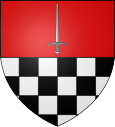Salavas
| Salavas | ||
|---|---|---|

|
|
|
| region | Auvergne-Rhône-Alpes | |
| Department | Ardèche | |
| Arrondissement | Largentière | |
| Canton | Vallon-Pont-d'Arc | |
| Community association | Gorges de l'Ardèche | |
| Coordinates | 44 ° 24 ' N , 4 ° 23' E | |
| height | 80-522 m | |
| surface | 17.11 km 2 | |
| Residents | 682 (January 1, 2017) | |
| Population density | 40 inhabitants / km 2 | |
| Post Code | 07150 | |
| INSEE code | 07304 | |
 Narrow streets in the old town center |
||
Salavas is a French municipality with 682 inhabitants (at January 1, 2017) in the department of Ardèche in the Region Auvergne Rhône-Alpes .
geography
Salavas is located on the right bank of the Ardèche across from Vallon-Pont-d'Arc with the famous natural arch of Pont-d'Arc. The Gorges de l'Ardèche begin on the territory of the municipality .
history
Dolmens and bronze objects found in the area indicate the settlement of the area in prehistoric times. In Gallo-Roman times and in the Middle Ages, there was a settlement on the area called La Gleyzasse , whose remains from the 11th century are protected as Inscrit Monument Historique .
The land was eventually sold to the Apchier family, who gave birth to the region's famous Merle, Baron de La Gorce and Salavas .
Even before the construction of the first Ardèche bridge, a ferry service connected the two banks of the river.
Population development
| year | 1962 | 1968 | 1975 | 1982 | 1990 | 1999 | 2007 | 2017 |
| Residents | 288 | 240 | 299 | 355 | 402 | 504 | 534 | 682 |
| Sources: Cassini and INSEE | ||||||||
Buildings and sights
The place is characterized by old houses that form an architectural unit and by old streets around the ruins of the medieval chateau. In addition to the parish church, Salavas has two other sacred buildings, the Romanesque palace chapel and the Huguenot temple.
A dam on the Ardèche is one of the municipality's modern structures. In 1988, an artificial canoe and kayak course was built here under the bridge to Vallon-Pont-d'Arc, which uses the gradient from the barrage to the deeper river bed.
economy
In earlier times mining was carried out based on the caves and grottoes in the area. Today agriculture and tourism dominate. In addition to wine and fruit growing, there is alpine farming with goat and sheep breeding.

